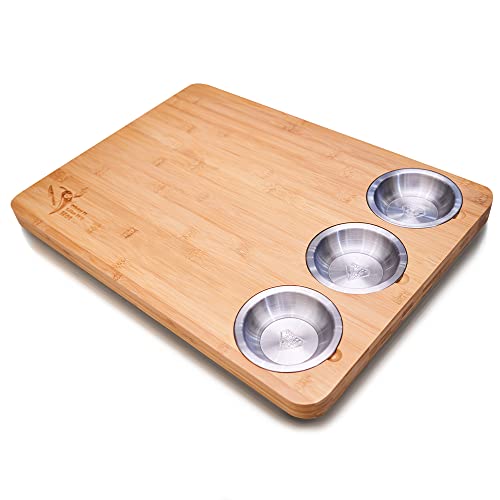In this step-by-step guide, I will walk you through the process of how to prevent bamboo cutting boards from warping. As bamboo cutting boards are a popular choice in many kitchens due to their durability and eco-friendly nature, it is important to take proper care of them to ensure they maintain their shape and functionality over time.
By following these simple steps, you can prevent your bamboo cutting board from warping and prolong its lifespan. From proper cleaning techniques to storing and maintaining the board, this guide will provide you with all the necessary information to keep your bamboo cutting board in excellent condition.
Whether you are a seasoned chef or a cooking enthusiast, this guide will help you understand the importance of maintaining your bamboo cutting board and provide you with practical tips to prevent warping. By implementing these strategies, you can enjoy using your bamboo cutting board for years to come.
Table of Contents
Top-rated eco-friendly cutting boards
Choose a high-quality bamboo cutting board
To choose a high-quality bamboo cutting board, start by selecting one that is made from sustainably sourced bamboo. Look for certification labels such as FSC (Forest Stewardship Council), which ensures that the bamboo used in the cutting board comes from responsibly managed forests. This not only helps protect the environment but also ensures that the bamboo is of good quality.
Next, examine the construction of the cutting board. A high-quality bamboo cutting board should have a sturdy construction that is resistant to warping and cracking. Look for a board that is at least 1 inch thick, as thinner boards may not be as durable. Additionally, check for smooth and even surfaces, as any unevenness can make cutting and chopping more difficult.
To ensure the cutting board is of good quality, also consider the manufacturing process. Look for boards that are made using a high-pressure lamination process, as this helps to increase the durability and strength of the board. Avoid boards that are simply glued together, as they may not hold up well over time.
Finally, consider the finish of the cutting board. Look for boards that have a food-safe and non-toxic finish, such as natural oils or beeswax. Avoid boards with varnish or lacquer finishes, as these can wear off over time and may not be safe for food preparation.
In summary, selecting a high-quality bamboo cutting board involves choosing one made from sustainably sourced bamboo, ensuring it has a sturdy construction, and considering the manufacturing process and finish. By following these guidelines, you can be confident in choosing a cutting board that is both environmentally friendly and of excellent quality.
Season the bamboo cutting board
To season a bamboo cutting board:
- Begin by cleaning the cutting board with warm soapy water and allow it to dry completely.
- Apply a food-grade mineral oil or bamboo oil to all surfaces of the board, including the edges, using a clean cloth or paper towel.
- Rub the oil into the board in a circular motion, ensuring an even coating.
- Let the oil soak into the bamboo for at least 15 minutes to half an hour.
- Wipe off any excess oil with a clean cloth or paper towel.
- Repeat this process 2-3 times, allowing each coat of oil to fully absorb before applying the next one.
- After the final coat, allow the cutting board to sit overnight to ensure complete absorption.
- Regularly apply a thin coat of oil to the board every few weeks or as needed to maintain its integrity and prevent moisture absorption.
Remember, seasoning your bamboo cutting board will help prolong its lifespan and maintain its quality.
Avoid prolonged exposure to water
To prevent warping, it is important to avoid prolonged exposure to water when it comes to caring for your bamboo cutting board. Instead of soaking it in water or leaving it submerged for extended periods, it is recommended to clean the board with a damp cloth or sponge. By following these simple steps, you can ensure the longevity and durability of your cutting board.
To clean your bamboo cutting board, start by dampening a cloth or sponge with water. Gently wipe the surface of the board, making sure to remove any food particles or residue. For tougher stains, a mild dish soap can be used, but make sure to rinse it thoroughly afterwards. Avoid using harsh cleaning agents, as they can damage the bamboo. Once you have finished cleaning, pat the board dry with a clean cloth and allow it to air dry completely before storing it.
Remember, avoiding prolonged exposure to water is crucial for maintaining the quality of your bamboo cutting board. By using a damp cloth or sponge, you can effectively clean the board without risking warping or damage.
Dry the cutting board properly
After cleaning, it is crucial to dry the bamboo cutting board properly to prevent any moisture from seeping into the board and causing damage. Begin by using a clean towel to thoroughly dry the surface of the board. Make sure to wipe both sides and all edges to remove any remaining water.
Alternatively, you can allow the cutting board to air dry in a well-ventilated area. Place it on a drying rack or prop it upright against a wall to ensure proper air circulation. Avoid leaving the cutting board in a damp or humid environment, such as near a sink or in a closed cupboard, as this can promote the growth of bacteria or mold.
By following these simple steps to dry your bamboo cutting board, you can ensure its longevity and maintain its quality. Remember, a dry cutting board is a clean and safe cutting board!
Store the cutting board properly
To store your bamboo cutting board properly, follow these simple steps:
- Find a dry and well-ventilated area: Look for a storage spot that is away from direct heat sources and excessive moisture. This will help prevent any potential damage to the bamboo and maintain its quality over time.
- Lay it flat: Instead of storing the cutting board upright, lay it flat on a clean and dry surface. This will ensure even weight distribution and prevent any warping or bending.
- Keep it clean and dry: Before storing, make sure the cutting board is completely clean and dry. Any leftover moisture can lead to mold or mildew growth, which can damage the board. Wipe it with a clean cloth and allow it to air dry completely before storing.
- Use a protective cover: If you have a protective cover or sleeve for the cutting board, it’s advisable to use it. This will provide an extra layer of protection against dust, dirt, and potential scratches.
By following these guidelines, you can store your bamboo cutting board properly, ensuring its longevity and keeping it in excellent condition for years to come.
Regularly maintain and condition the board
To regularly maintain and condition the board, it is important to periodically apply a thin layer of food-grade mineral oil or bamboo oil. This helps to keep the cutting board moisturized and protected against warping. Following the manufacturer’s instructions for maintenance is crucial to ensure the longevity of the board.
To apply the oil, start by cleaning the cutting board thoroughly with warm soapy water and a sponge. Rinse it well and allow it to dry completely before proceeding. Next, pour a small amount of the oil onto the surface of the board. Using a clean cloth or paper towel, spread the oil evenly across the entire surface, making sure to cover all sides and edges. Allow the oil to penetrate the wood for at least 15-20 minutes.
Once the oil has had time to soak in, use a clean cloth to wipe away any excess oil from the surface. This step is important to prevent any residue from transferring onto food during use. After wiping away the excess oil, let the cutting board sit for a few hours or overnight to fully absorb the oil. If desired, you can repeat this process once a month or as recommended by the manufacturer to maintain optimal board condition.
Remember, using food-grade mineral oil or bamboo oil specifically designed for cutting boards is essential. Avoid using vegetable oils or other types of oils as they can turn rancid over time and affect the taste and safety of your food. With regular maintenance and conditioning, your cutting board will remain in excellent condition, ready to serve you in your culinary endeavors.
Ensuring Longevity and Quality
In conclusion, keeping your bamboo cutting board in great condition and preventing warping is achievable through a few simple steps. By following the tips mentioned in this blog post – such as investing in a high-quality board, seasoning it, avoiding excess water, drying it properly, storing it correctly, and regular maintenance – you can ensure that your bamboo cutting board remains in excellent shape for a long time. These preventive measures will not only increase its lifespan but also provide you with a reliable and durable cutting surface for all your culinary endeavors. So go ahead and implement these suggestions to enjoy the benefits of a warp-free bamboo cutting board in your kitchen.

